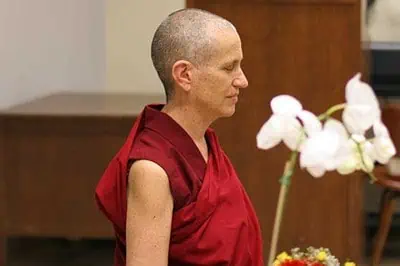Taking refuge in the guru
Stages of the Path #52: Refuge Ngöndro Part 1
Part of a series of short talks on the preliminary practice (ngöndro) of taking refuge.
- Ngöndro practices create merit and purify negativities
- Seeing the teacher as the ultimate guru or the Buddha
- Taking refuge in the teacher is taking refuge in the teachings they teach
Stages of the Path 52: Refuge and guru refuge (download)
We finished refuge yesterday. I didn’t go into the description of the Buddha, Dharma, and Sangha in great depth because I thought that a lot of that contains the different lists of qualities and things like that—and I didn’t want to go through them. But it’s quite inspiring to study it. What I was thinking of doing is going into the ngöndro practice of refuge.
There are various ngöndro practices. One is taking refuge. It’s a very wonderful practice because the ngöndro and preliminary practices, which are preliminary for a tantric retreat, are practices to create merit and purify negativities—and so refuge is one of those. Of the four Tibetan traditions, they have different ways of doing it. The particular way that we do it is as a separate practice, not done in conjunction with prostrations or something else, but as a separate practice. We recite, “I take refuge in the guru, I take refuge in the Buddha, I take refuge in the Dharma, I take refuge in the Sangha” 100,000 times plus 10 percent, and 10 percent of 10 percent and so on. (111,111) The point is not the counting; the point is the actual feeling of taking refuge in the guru, Buddha, Dharma, and Sangha.
It’s quite a lovely practice. I can start talking tomorrow about the visualization that you do and also the way you use the visualization. You think of negativities created in reference to the guru, Buddha, Dharma, and Sangha, and purify those specifically. Then also their particular qualities—you imagine those qualities coming into you.
Some people have some questions about why the guru is considered when you’re doing the refuge ngöndro. “Everybody talks about the Three Jewels and here the Tibetan tradition has the guru, and what’s the story here?” When you’re talking about the guru as the refuge you’re not talking about the personality of your spiritual teacher. It’s really important to understand that the guru as an object of refuge is what is called the “ultimate guru,” which is basically the Buddha. It comes down to the omniscient mind of all of the Buddhas that manifest in all these different forms. That’s what is meant by the ultimate guru, and that is the guru that we take refuge in.
It’s not the personality of the teacher. But rather, we see the teacher in tantric practice—I’m not talking about sutra practice but in tantra practice—as actually being the buddha, and, actually, in the pāramitā practice we see the teacher as the manifestation of the Buddha. It doesn’t involve getting attached to the teacher’s personality and the teacher as a human being. It’s very much seeing the teacher as a manifestation there to guide us. The reason for this is that it helps our mind to take the advice more seriously.
The downside is if we get very attached to the teacher as a personality and think that that person is our refuge. That person is impermanent and is one day going to leave this body. Then, if we’re very attached in that way, at that point it’s like our refuge is lost and we don’t know where to turn. That’s why it’s very important to see that the guru we’re taking this refuge in is nothing other than the embodiment of the Buddha, Dharma, and Sangha—which are not going to disappear when the physical body of our teacher is no longer here. I say this because I have seen many people, when their teacher dies, they’re going, “What do I do now?” Whereas, if you have really thought about this deeply, it’s not the teacher as the person, it’s the Dharma that you’ve learned, and it’s the teacher’s qualities that act as a model for what you want to become. When your teacher is not there physically, the Dharma that they taught you is certainly there. The Dharma in their minds is there for you to study and access and practice and realize in your own mind. That is the way that we’re taking refuge in the guru—that’s quite important. It’s not a fourth object of refuge. It’s seen as the embodiment of the Buddha, Dharma, and Sangha.
So if anybody has a picture—I’m trying to think of the refuge visualization—because the way it looks like is: there’s one large throne and then on it there are five smaller thrones. But when they depict it in a painting it looks kind of like the merit field, but also different because the central figure is Śākyamuni Buddha instead of Lama Tsongkhapa; and also because it’s one big throne with five thrones on it instead of a tree growing out of a milk ocean with this big lotus on top of it.
Venerable Thubten Chodron
Venerable Chodron emphasizes the practical application of Buddha’s teachings in our daily lives and is especially skilled at explaining them in ways easily understood and practiced by Westerners. She is well known for her warm, humorous, and lucid teachings. She was ordained as a Buddhist nun in 1977 by Kyabje Ling Rinpoche in Dharamsala, India, and in 1986 she received bhikshuni (full) ordination in Taiwan. Read her full bio.

